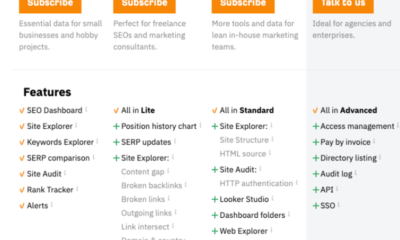Politics
7 Ways to Become an Entrepreneur – No Experience Required
Published
2 years agoon
By
Drew Simpson
The pandemic, coupled with a tight labor market and the churn of American employees quitting their jobs en masse, gave life to a wave of new entrepreneurs in recent years. As workers decided to ditch the nine-to-five work-life in hopes of pursuing something more meaningful and entrepreneurial — they became entrepreneurs.
A Pew Research study found significant job losses in the earlier months of the pandemic. Low pay, minimal job growth, and a toxic working environment were among the top reasons so many Americans quit their jobs in the wake of the Great Resignation — the rush for many previous laborers is now to start the business they’ve always dreamt of.
Be among those who are starting businesses now — no experience required
After a tumultuous two years and a slow economic recovery, 2021 saw a record number of new businesses coming to life, with nearly 5.4 million unique business applications throughout the year. This year has also been off to a positive start, with more than 423,000 new business applications in April alone – a 1.6% increase from the month before.
So while thousands, if not millions of people, may be willing to leap into the world of entrepreneurship, many might be wondering how they can get in on it without experience, or even the finances.
Anything is possible in this world right now — especially because of technology
Yes, anything is possible in the modern world of technology, cloud computing, and remote work. Moreover, if the last few years of the crisis have taught us anything, humankind is quite resilient against uncertainty.
If you’re on the edge about becoming an entrepreneur, but still need a little bit more motivation — here are seven ways to become an entrepreneur without experience.
What is an entrepreneur?
Let’s start with the simple things first. There are a lot of definitions and explanations that float around on what a real entrepreneur is. And while it’s not possible to say which is right or wrong, an essay on How To Become A Successful Entrepreneur published on IPL has perhaps the most meaningful definition.
According to the author, “There is no single absolute profile on who can turn out to be an entrepreneur. Successful entrepreneurs arise from different gender, race, ages, and income levels. They differ in experience and education. […] They include determination, leadership, flexibility, creativity, self-confidence, passion, and ‘smarts.’”
On the other hand, when you search for the definition of an entrepreneur on Merriam Webster, it states that an entrepreneur is someone “who organizes, manages, and assumes the risks of a business or enterprise.”
Suppose we combine these attributes and assume that entrepreneurs manage business and enterprise-related risks. In that case, it’s entirely possible we can pick up these traits in a broad spectrum of people.
From the office worker to the innovator, or perhaps someone with a brilliant business idea, but with no business background – there’s a chance that any person can become an entrepreneur if they’re determined and willing to succeed and take risks.
How to become an entrepreneur without any experience
Now that we have a general understanding of what an entrepreneur could be or the attributes thereof, we can look at the relatively straightforward ways for you to become a successful entrepreneur – no experience required.
Identify Opportunities
Before getting started or diving headfirst into the business world, one should identify opportunities within your community or area first.
So how do you identify an opportunity or gap in the market?
Perhaps the easiest way is to think of a service or product you were recently looking to acquire and ask yourself:
- How many available options did I have at my disposal?
- Was it challenging to find what I was looking for within my immediate vicinity or community?
- If not, where did you go to find what you were looking for?
- Is it possible that other people, like myself, struggle to find this service or product?
- What will it take to narrow the gap to bring these goods or services closer into my community?
- Why is there a lack thereof, and how can one fix it?
While these questions cover a broad spectrum, it’s possible to add more to them that can help you determine the opportunity or where you can find one.
Another great way is to talk to your friends or family about the frustration you might have over not finding what you’re looking for.
Thinking of ways in which you can make a difference starts with a problem. Seek out the problem, and see how you can solve it, either with the aid of a service or product, or even both if necessary.
Seek An Answer To A Demand
If you come across a category or perhaps categories of things people are demanding within their immediate reach, seek out an answer to it.
This ties in nicely with what we mentioned previously. If you notice a gap in the market for something and you can seek out an answer as to why it’s so, you might be onto a prospective business idea.
The best is to keep it simple at first. Don’t try and make things too complex, or think of a new product or service entirely. Instead, look for ways in which you can make people’s lives easier with the concepts you have at hand.
Is there a need for something that you know about and people are willing to pay a high premium for it? Are people willing to head to another city or town to purchase “the something” you are thinking about? Maybe you notice that there’s a big crowd of consumers interested in something but unwilling to make adjustments to have easier access to it.
It’s best to see where the demand is, ask yourself where the demand is coming from, your target audience or customers, and then go after them. Start with the people you can serve first, and then go further.
Network With Business Owners and Entrepreneurs
This article is about learning how to become an entrepreneur when you don’t have the skills or basic knowledge, and a simple way to do so is by networking with other like-minded people.
If you know of a business owner or entrepreneur that recently opened a new startup or business, approach them with some questions, or even converse over the topic of owning and running your own business.
It doesn’t have to be a formal Q&A; you can keep things light and simple at first.
Take time to learn from them and how they managed to find a gap in the market, and then provide a solution for it.
Consider talking or networking with those business owners and entrepreneurs that work within the ecosystem you’d like to trade-in. It doesn’t have to be your direct competition, if any, but networking is the best way you learn and grow your contact list.
Maybe you’ve been thinking of opening an indoor plant shop in a new town you recently moved to but are not quite sure about the local demographic, the seasonality of the area, or even what rent for a small space would cost you. This is the perfect time to talk to a local small business owner who’s been in the area for some time and who’s already made a name for themself.
Make time to learn from a fellow business owner or entrepreneur. You can do simple and cheap things like these to grow your knowledge and understanding of business and how you can get going.
See What Others Are Doing to become an entrepreneur
Let’s say, for example, you’ve been thinking of opening an indoor plant shop after you’ve realized there’s nothing similar or so specific in your town. After visiting some local nurseries, big box stores, or garden centers, you realized they only offer a small selection of indoor plants, but nothing niche or exotic that could draw significant attention.
You can look at what they offer and how they operate their business. So, for example, if it’s perhaps a small nursery that focuses primarily on botanicals that grow within the area, then you know they might now offer the services or products something who’s looking to buy an indoor house plant will be looking for.
The garden center focuses more on large trees, shrubs, cement pots, and garden supplies. Although at the same time, the big box nursery does have some indoor plants, they charge a high premium on their products and can help you order something from another major city, but that will only make it more expensive.
Hypothetically speaking, if you look at what these places are doing, and how they’re missing an opportunity that’s perhaps right in front of them, you’re closing in on a chance to provide an answer to a demand.
Of course, it wouldn’t help if you’re the only person in the town who’s really into indoor plants, as you might need to consider the demographic and the general market. You can ask around social media groups, research where people get their plants from, etc.
There are different ways to approach an idea, and looking at what others are doing, whether you agree with it or not, gives you some clarity on where you can avoid inevitable mistakes, or make improvements that will help you become more noticeable.
Research, Read and Write about entrepreneurs
If you perhaps haven’t noticed any specific service or product needed in your area, take some time to do some research, read up about it, and write down your thoughts and ideas.
Research
Look at your community, and see if there is anything you would like to improve or add to help you and your peers benefit from it. Ask your neighbors or friends in the area if they’ve ever come across something they wish the town had.
Look into why there is a shortage, and how you resolve it. Perhaps you notice that some businesses are monopolizing a specific niche, and you can offer it for cheaper, and even better. If you see a problem in your research, it’s perhaps time to address it.
Read
Nothing helps as much as reading up on new trends and what’s happening in the business and entrepreneurship world. Yes, it’s not the most exhilarating literature out there, but you might stumble across an idea, or concept that you think would work perfectly for your market.
Write
A great way to get ideas out there is to write them down. If you think of something new, write it down and revisit it in a few days. Perhaps within that time, you thought of something else, or a new concept that could work even better. One idea always leads to another.
If you’re comfortable enough sharing it with a friend or family member, maybe even a fellow business owner or entrepreneur, approach them with it and see what they have to add. Getting a second or third opinion helps you change your perspective and can add some value to your ideas.
Look For Trends
Trends come and go so quickly in the fast-moving world of online business, social media, and the internet. And while a trend is something that doesn’t perhaps last very long within the more significant consumer market, maybe you can monetize something for a bit that could help you realize the fuller and better potential of a different idea.
Trends are everywhere, and depending on which industry or market you’re looking to capitalize in, you can bring trends to the market without having to break a sweat over them.
Trends are fast-moving
It might be a bit tricky, as trends are a fast-moving scenario, and often, people don’t want to associate with a specific trend. But, even though this is possible, you can perhaps take a trend and modify it, which can help you see it differently.
Let’s take indoor plants as an example again. However, it might be a massive trend at the moment; with countless social media pages and boards dedicated to them; there’s still a growing demand for high-quality and exotic plants.
People have realized that while plants are trendy, hip, cool, and make your home look beautiful, there’s more to it than just being an aesthetic decor piece.
From handmade pots, woven baskets, macrame, and fertilizer, to organic plant food and fertilizers – these products and services offer a subgenre or sub category to a trend that’s been alive and well for quite some time now.
Looking for trends
When looking for a trend, see how you can future-proof it by adding more services and products, or even by creating a sub-category that can serve the greater need of the market while being on-trend.
Try and get into the minds of the people following a specific trend, and think about what they would like to see as the next big thing.
Know the industry that you want to go into
While you might have a business idea that could work within your community, the more significant industry that could help fuel your business can be a whole different ball game on its own.
Getting to know the industry is not only an intelligent way to learn, but it can also give you some input on where you can make some adjustments to your business plan.
Who will be your suppliers?
Whatever industry you’re looking to operate in, you should know who your potential suppliers are, where they’re located, who else they supply in your area or market, and can they offer your needs – if not, who else can you ask for? Assistance. Why has certain aspects of that industry not yet worked in your local business market, is there a need or demand thereof, etc.
If you’re able to lift the curtain into the industry, you’ll be able to learn a lot more than other entrepreneurs.
The ins and outs of every industry are not the same, and sometimes one thing, in theory, is a lot different in practice. Being prepared can help you see where you could potentially run into problems.
Learn about your industry
Getting to know the industry is like starting a business from the inside out. You’ll not only learn a lot more, but it will also set you up for different ways to think about your potential business plan and idea.
Some Final Thoughts about becoming an entrepreneur
While there are certainly more than seven ways to become an entrepreneur, starting simple first can help you overcome a lot of the noise surrounding entrepreneurship.
For the most part, with all of its technologies and digital tools, the modern world has helped set us up with the equipment we need to grow our understanding of our markets, the industry, and how we can resolve business-related problems.
Are you up to the challenge of being an entrepreneur?
Being an entrepreneur is now an easier challenge than before — and you’ll learn a lot on the job. So instead of running around doing research, and talking to everyone constantly, perhaps it’s time you take the leap and just start your business — that’s the only way we really learn.
Image Credit: Photo by RODNAE Productions; from Pexels; Thank you!
Jacob Wolinsky
CEO of Valuewalk
I am the founder and CEO of ValueWalk a popular investing site. Before working at ValueWalk full time, I was as a stock analyst first at a micro-cap focused private equity firm. After that, I worked as a stock analyst at a small and mid cap focused research shop. Following that, I worked in business development for hedge funds.
Despite having an investing background, I am fascinated by tech and am currently working on a few tech related apps. Stay tuned for some news on that!
I live with my wife and four kids in Passaic New Jersey.
You may like
-


Four ways AI is making the power grid faster and more resilient
-


Customer experience horizons
-


Plastic is a climate change problem. There are ways to fix it.
-


15 Proven Ways to Increase Customer Engagement and Build Loyalty
-


Four Clever Ways to Use Tiered Pricing for Maximum Profit
-


5 Ways to Reduce Customer Churn
Politics
Fintech Kennek raises $12.5M seed round to digitize lending
Published
6 months agoon
10/11/2023By
Drew Simpson
London-based fintech startup Kennek has raised $12.5 million in seed funding to expand its lending operating system.
According to an Oct. 10 tech.eu report, the round was led by HV Capital and included participation from Dutch Founders Fund, AlbionVC, FFVC, Plug & Play Ventures, and Syndicate One. Kennek offers software-as-a-service tools to help non-bank lenders streamline their operations using open banking, open finance, and payments.
The platform aims to automate time-consuming manual tasks and consolidate fragmented data to simplify lending. Xavier De Pauw, founder of Kennek said:
“Until kennek, lenders had to devote countless hours to menial operational tasks and deal with jumbled and hard-coded data – which makes every other part of lending a headache. As former lenders ourselves, we lived and breathed these frustrations, and built kennek to make them a thing of the past.”
The company said the latest funding round was oversubscribed and closed quickly despite the challenging fundraising environment. The new capital will be used to expand Kennek’s engineering team and strengthen its market position in the UK while exploring expansion into other European markets. Barbod Namini, Partner at lead investor HV Capital, commented on the investment:
“Kennek has developed an ambitious and genuinely unique proposition which we think can be the foundation of the entire alternative lending space. […] It is a complicated market and a solution that brings together all information and stakeholders onto a single platform is highly compelling for both lenders & the ecosystem as a whole.”
The fintech lending space has grown rapidly in recent years, but many lenders still rely on legacy systems and manual processes that limit efficiency and scalability. Kennek aims to leverage open banking and data integration to provide lenders with a more streamlined, automated lending experience.
The seed funding will allow the London-based startup to continue developing its platform and expanding its team to meet demand from non-bank lenders looking to digitize operations. Kennek’s focus on the UK and Europe also comes amid rising adoption of open banking and open finance in the regions.
Featured Image Credit: Photo from Kennek.io; Thank you!
Radek Zielinski
Radek Zielinski is an experienced technology and financial journalist with a passion for cybersecurity and futurology.
Politics
Fortune 500’s race for generative AI breakthroughs
Published
6 months agoon
10/11/2023By
Drew Simpson
As excitement around generative AI grows, Fortune 500 companies, including Goldman Sachs, are carefully examining the possible applications of this technology. A recent survey of U.S. executives indicated that 60% believe generative AI will substantially impact their businesses in the long term. However, they anticipate a one to two-year timeframe before implementing their initial solutions. This optimism stems from the potential of generative AI to revolutionize various aspects of businesses, from enhancing customer experiences to optimizing internal processes. In the short term, companies will likely focus on pilot projects and experimentation, gradually integrating generative AI into their operations as they witness its positive influence on efficiency and profitability.
Goldman Sachs’ Cautious Approach to Implementing Generative AI
In a recent interview, Goldman Sachs CIO Marco Argenti revealed that the firm has not yet implemented any generative AI use cases. Instead, the company focuses on experimentation and setting high standards before adopting the technology. Argenti recognized the desire for outcomes in areas like developer and operational efficiency but emphasized ensuring precision before putting experimental AI use cases into production.
According to Argenti, striking the right balance between driving innovation and maintaining accuracy is crucial for successfully integrating generative AI within the firm. Goldman Sachs intends to continue exploring this emerging technology’s potential benefits and applications while diligently assessing risks to ensure it meets the company’s stringent quality standards.
One possible application for Goldman Sachs is in software development, where the company has observed a 20-40% productivity increase during its trials. The goal is for 1,000 developers to utilize generative AI tools by year’s end. However, Argenti emphasized that a well-defined expectation of return on investment is necessary before fully integrating generative AI into production.
To achieve this, the company plans to implement a systematic and strategic approach to adopting generative AI, ensuring that it complements and enhances the skills of its developers. Additionally, Goldman Sachs intends to evaluate the long-term impact of generative AI on their software development processes and the overall quality of the applications being developed.
Goldman Sachs’ approach to AI implementation goes beyond merely executing models. The firm has created a platform encompassing technical, legal, and compliance assessments to filter out improper content and keep track of all interactions. This comprehensive system ensures seamless integration of artificial intelligence in operations while adhering to regulatory standards and maintaining client confidentiality. Moreover, the platform continuously improves and adapts its algorithms, allowing Goldman Sachs to stay at the forefront of technology and offer its clients the most efficient and secure services.
Featured Image Credit: Photo by Google DeepMind; Pexels; Thank you!
Deanna Ritchie
Managing Editor at ReadWrite
Deanna is the Managing Editor at ReadWrite. Previously she worked as the Editor in Chief for Startup Grind and has over 20+ years of experience in content management and content development.
Politics
UK seizes web3 opportunity simplifying crypto regulations
Published
6 months agoon
10/10/2023By
Drew Simpson
As Web3 companies increasingly consider leaving the United States due to regulatory ambiguity, the United Kingdom must simplify its cryptocurrency regulations to attract these businesses. The conservative think tank Policy Exchange recently released a report detailing ten suggestions for improving Web3 regulation in the country. Among the recommendations are reducing liability for token holders in decentralized autonomous organizations (DAOs) and encouraging the Financial Conduct Authority (FCA) to adopt alternative Know Your Customer (KYC) methodologies, such as digital identities and blockchain analytics tools. These suggestions aim to position the UK as a hub for Web3 innovation and attract blockchain-based businesses looking for a more conducive regulatory environment.
Streamlining Cryptocurrency Regulations for Innovation
To make it easier for emerging Web3 companies to navigate existing legal frameworks and contribute to the UK’s digital economy growth, the government must streamline cryptocurrency regulations and adopt forward-looking approaches. By making the regulatory landscape clear and straightforward, the UK can create an environment that fosters innovation, growth, and competitiveness in the global fintech industry.
The Policy Exchange report also recommends not weakening self-hosted wallets or treating proof-of-stake (PoS) services as financial services. This approach aims to protect the fundamental principles of decentralization and user autonomy while strongly emphasizing security and regulatory compliance. By doing so, the UK can nurture an environment that encourages innovation and the continued growth of blockchain technology.
Despite recent strict measures by UK authorities, such as His Majesty’s Treasury and the FCA, toward the digital assets sector, the proposed changes in the Policy Exchange report strive to make the UK a more attractive location for Web3 enterprises. By adopting these suggestions, the UK can demonstrate its commitment to fostering innovation in the rapidly evolving blockchain and cryptocurrency industries while ensuring a robust and transparent regulatory environment.
The ongoing uncertainty surrounding cryptocurrency regulations in various countries has prompted Web3 companies to explore alternative jurisdictions with more precise legal frameworks. As the United States grapples with regulatory ambiguity, the United Kingdom can position itself as a hub for Web3 innovation by simplifying and streamlining its cryptocurrency regulations.
Featured Image Credit: Photo by Jonathan Borba; Pexels; Thank you!
Deanna Ritchie
Managing Editor at ReadWrite
Deanna is the Managing Editor at ReadWrite. Previously she worked as the Editor in Chief for Startup Grind and has over 20+ years of experience in content management and content development.
